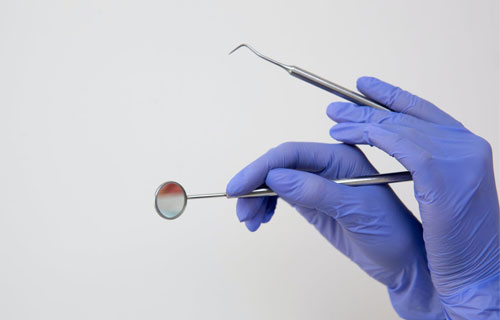Application of silica in the fields of rubber, plastics and coatings
Silica is widely found in nature, and it is the main component of ceramics, glass and other non-metallic products. In particular, ultrafine silica has a large specific surface area, strong surface adsorption force, large surface energy, high chemical purity, good dispersion performance, thermal resistance, electrical resistance, etc. due to its small particle size. With its superior stability, reinforcement, thickening and thixotropy, it is widely used in rubber, plastics, coatings and other fields.
Rubber
- Application in vulcanized silicone rubber
The most widely used in rubber is fumed silica, which is mainly used as a reinforcement in vulcanized silicone rubber. Because the molecular chain of silicone rubber is very flexible and the molecular interaction between the chains is very weak, the strength of the unreinforced rubber is very weak and has no use value. It must be reinforced before it can be used.
- Application in medical rubber
The rubber with fumed silica as a reinforcing agent has good physical properties and has a wide range of applications in medical treatment. Its products involve various departments of medicine, such as craniocerebral surgery, ENT, anesthesiology, digestive system, cardiac surgery, and abdominal surgery. Surgery, urinary and reproductive system, etc. At the same time, sterile rubber medical gloves and disposable rubber examination gloves, medical hoses and medical silicone rubber catheters, medical bottle stoppers and artificial silicone rubber organs are also medical rubber products. As a medical rubber product, it must meet the requirements of non-toxic, chemically inert, non-allergenic, non-pathogenic, non-deformable, easy to process, and good anti-aging properties. Silicone rubber can basically meet these requirements.

- Application in tire rubber
Compared with carbon black, nano-silica filled green tires have low rolling resistance and low fuel consumption, so they can replace the trend of carbon black filled car and truck tires. Now the concept of green tires has emerged. Green tires not only refer to fuel-efficient, safe, and low rolling resistance tires, but also meet the greening of raw materials and production processes.

- Application in daily necessities
Nano-silica has good reinforcing properties and can improve the physical and mechanical properties of rubber. It is widely used in household appliances and rubber products in cultural and sports education.
- Role in hose tape and rubber shoes
Hose tape is two important parts in the rubber industry. In its production process, it is necessary to improve its wear resistance and fatigue resistance, so white carbon black needs to be added to meet the requirements of use.
In rubber shoes, especially in shoe soles, white carbon black can replace carbon black 100%, so rubber shoes are one of the industries that consumes more white carbon black. As a reinforcing filler, white carbon can enhance the wear resistance, tensile strength, tear strength and hardness of the sole, so it is widely used in the production of light-colored, colored translucent and transparent soles.
Plastic
- Application in thermoplastics
The traditional method of toughening plastics is to add rubber-like substances to the matrix. Although this method greatly improves the toughness of the material, it also greatly reduces the strength and processing performance of the material.
The toughening principle of fumed silica toughened plastics is the toughening of inorganic rigid particles. After it is added to the plastic, it can improve the toughness of the material without weakening the rigidity of the material, and even increase the rigidity of the material.
- Application in thermosetting plastics
Adding fumed silica to epoxy resin can significantly improve its brittleness, overcome the defects of material rigidity and strength reduction caused by the toughening of elastomers, and achieve the purpose of strengthening and toughening.
- As a flame retardant additive
Because fumed silica increases the strength of the carbon-silicon layer through the physical process in the condensed phase, it can prevent the transfer of heat and substances during combustion. By adding fumed silica to the EVA/MH blend and reducing the total filling amount, the elongation at break can be doubled when the flame retardant properties remain unchanged.
Coating
- Application in light-curing coatings
Ultraviolet curing coating (UVCC) is an environmentally friendly and energy-saving coating developed in the 1960s. Compared with traditional coatings, it has the characteristics of economy, environment friendliness, energy saving and high efficiency. Its disadvantages are that the equipment and raw materials are more expensive, the adhesion is poor, and it is easy to crack.
Filling the nano-silica into the ultraviolet curable coating can significantly increase the hardness of the coating after curing, and also improve the heat resistance. At the same time, it can improve the curing speed, hardness, adhesion and thermal stability of the UV-curable coating film at low temperature.
Studies have also shown that the presence of nano-silica can significantly improve the wear resistance, hardness, impact strength and flexibility of epoxy acrylate UV curable coatings.
- Application in architectural coatings
Nano-silica can effectively reduce the color difference of the coating caused by ultraviolet and infrared light irradiation, and improve the aging resistance of exterior wall coatings. It can also significantly enhance the hardness, adhesion and weather resistance of the coating, increase the viscosity and anti-settling ability of the coating, and enhance the stability of the coating.

- Application in color inkjet printing paper coating
Color inkjet printing paper can often be used in daily life, especially many large companies often use it for document printing. However, due to the micropores and cracks on the surface, it is necessary to have a primer to improve the performance of this paper. And if nano-silica is added to the primer, it can not only effectively improve the effect of the primer, but also improve the overall quality of the paper, and provide good absorption performance for the paper.
Moreover, if nano-silica is added to the pigment, a special coating for digital color inkjet printing paper with good performance can be made, which not only can make the coating load moderate, but also can effectively solve the problem of formaldehyde, the printing effect is good, and the material is easy. Yes, it can be said to be economical and useable.
- Application in plastic coatings
Nano-silica can also have a good promoting effect on the related thermal properties of polyethylene, not only can effectively improve the thermal stability of the composite material, but also the flame retardant performance will be greatly improved. It can be said that in the application of plastic coatings, nano-silica can fully improve the overall quality of the coating.
- Application in metal protective coatings
The use of silica is very extensive in the field of coatings, especially if nano silica is added to metal protective coatings, the quality of the coatings will also be further improved. Many researchers have tried nano-silica, and the results show that nano-silica can significantly enhance the strength of the carbon layer of metal protective coatings, and it will also increase the fire resistance of steel building materials.
Article source: China Powder Network
